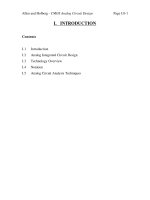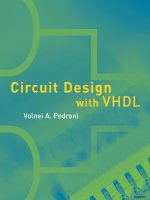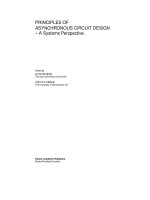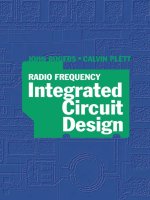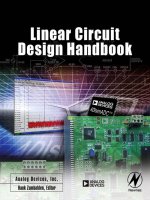Springer cmos logic circuit design
Bạn đang xem bản rút gọn của tài liệu. Xem và tải ngay bản đầy đủ của tài liệu tại đây (30.58 MB, 550 trang )
!!!!൞䶂ࢬڇ吨再ऱ㪤ء䶣֮䱀طFQVCDO!HSPVQࠫנ܂Ζ
!!!!ء䢰ठ䰏㢖ڶࢬृ܂ΔFQVCDO!HSPVQᖞΕࠫ܂Ε伵䦡ؒՠ܂Ζڇঅ兓ᄭ֮䱀㡕୲ݙᖞΕ
㨕ऱൣ㤝ՀΔ൞אױ㢑֮ء䱀劓۩剖剧Ζ࣠ڕ൞ኩრΔ冉ڇ剖剧ऱ㦍ଢ㡹Ղݺ䣙ऱ伵劖൷Δ㪤Ոਢ㢑
ݺ䣙ՠ܂ऱ༇ૹΖ
!!!!࣠ڕ൞Ꮑࠌ֮ءش䱀խऱຝ։ࢨृ٤ຝ㡕୲ΔشאՊਬẊ䢓شຜΔ冉侶ߓ֮䱀ृ܂Δڇ܂
ृٵრൣ㤝ՀΔ൞אױ佀但൞ऱ۩䢠Ζ࣠ڕ܀൞㦠ڶٵृ܂რۖᖐ۞شՊਬẊ䢓ࢨॺ䢓ؾऱ
ΔFQVCDO!HSPVQ㰒լ㢑ڼ凔ٚ۶凘ٚΖ
!!!!࣠ڕ൞ڶრڇ伵Ղנठ൞ऱ܂Δࢨृ൞ړ܂ࠫڶऱ伨㧄䰏䣠ᐾऱ܂Δݺ䣙ॺൄ㣴०൞ٌ
ղݺ䣙䢠൞܍凮䣠ᐾࡉ䦡ؒΔ侶伵ॾᒣਢΚfqvcdoAnto/dpnΖ
!!!!㣴०兑向ݺ䣙ऱీΜຏ㧄ీΔ൞אױ㸀܍ڍޓ凮凹允ᩓՀ剧Ζݺ䣙ऱీܿچਢΚ
iuuq;00xxx/fqvcdo/dpnΖ
!!!!㣴०ףԵݺ䣙ऱ兌䨫Μຏ㧄兌䨫Δ൞㰒ףԵFQVCDO!HSPVQՕ୮அΔ伬兘ڍޓऱٵݳሐٽऱ֖ࣛΔڢ
ᩓה䣙։ࠆ凹ᄭΜݺ䣙ऱ兌䨫ܿچਢΚiuuq;00xxx/fqvcdo/pshΖ
!!!!࣠ڕ൞ڶٚ۶ጊ向ࢨृრ儁Ε৬兀Δ冉൞ᩓݺ䣙侶伵Ζ侶伵ॾᒣΚfqvcdoAnto/dpnΖ
!!!!່ٿΔ٦ڻტ冴൞Հ剧ڢ吨再طFQVCDO!HSPVQࠫנ܂ऱ䶣נठढΖ
CMOS LOGIC CIRCUIT DESIGN
This Page Intentionally Left Blank
CMOS LOGIC CIRCUIT DESIGN
John P. Uyemura
Georgia Institute of Technology
KLUWER ACADEMIC PUBLISHERS
NEW YORK, BOSTON, DORDRECHT, LONDON, MOSCOW
eBook ISBN:
Print ISBN:
0-306-47529-4
0-7923-8452-0
©2002 Kluwer Academic Publishers
New York, Boston, Dordrecht, London, Moscow
Print ©2001 Kluwer Academic Publishers
Dordrecht
All rights reserved
No part of this eBook may be reproduced or transmitted in any form or by any means, electronic,
mechanical, recording, or otherwise, without written consent from the Publisher
Created in the United States of America
Visit Kluwer Online at:
and Kluwer's eBookstore at:
Dedication
This book is dedicated to
Christine and Valerie
for all of the joy and happiness
that they bring into my life
This Page Intentionally Left Blank
Preface
This book is based on the earlier Kluwer title Circuit Design for CMOS/VLSI
which was published in 1992. At that time, CMOS was just entering the mainstream as a technique for high-speed, high-density logic circuits. Although the
technology had been invented in the 1960’s, it was still necessary to include Section 1.1 entitled Why CMOS? to justify a book on the subject. Since that time,
CMOS has matured and taken its place as the primary technology for VLSI and
ULSI digital circuits. It therefore seemed appropriate to update the book and generate a second edition.
Background of the Book
After loading the old files and studying the content of the earlier book, it became clear to me that
the field is much more stable and well-defined than it was in the early 1990’s. True, technological
advances continue to make CMOS better and better, but the general foundations of modern digital
circuit design have not changed much in the past few years. New logic circuit techniques appearing
in the literature are based on well-established ideas, indicating that CMOS has matured.
As a result of this observation, the great majority of the old files were abandoned and replaced
with expanded discussions and new topics, and the book was reorganized to the form described
below. There are sections that didn’t change much. For example, Chapter 1 (which introduces
MOSFETs) includes more derivations and pedagogical material, but the theme is about the same.
But, many items are significantly different. For example, the earlier book contained about 60 pages
on dynamic logic circuits. The present volume has almost three times the number of pages dedicated to this important area. In addition, the book has been written with more of a textbook flavor
and includes problem sets.
Contents
Chapter 1 introduces the MOS system and uses the gradual-channel approximation to derive the
square-law equations and basic FET models. This sets the notation for the rest of the book. Bulkcharge models are also discussed, and the last part of the chapter introduces topics from smalldevice theory, such as scaling and hot electrons.
viii
Chapter 2 is an overview of silicon fabrication and topics relevant to a CMOS process flow.
Basic ideas in lithography and pattern transfer are covered, as are items such as design rules, FET
sizing, isolation, and latch-up. This chapter can be skipped in a first reading, but it is important to
understanding some problems that are specific to layout and fabrication issues. It is not meant to
replace a dedicated course in the subject.
Circuit design starts in Chapter 3, which is a detailed analysis of the static CMOS inverter. The
study is used to set the stage for all of the remaining chapters by defining important DC quantities,
transient times, and introducing CMOS circuit analysis techniques. Chapter 4 concentrates on a
detailed study of the electrical characteristics of FETs when used as voltage-controlled electronic
switches. In particular, the treatment is structured to emphasize the strong and weak points of
nFETs and pFETs, and how both are used to create logic networks. This feeds into Chapter 5,
which is devoted entirely to static logic gates. This includes fully complementary designs in addition to variants such as pseudo-nMOS circuits and novel XOR/XNOR networks. Chapter 6 on
transmission gate logic completes this part of the book.
Dynamic circuit concepts are introduced in Chapter 7. This chapter includes topics such as
charge sharing and charge leakage in various types of CMOS circuit arrangements. RC modelling
is introduced, and the Elmore formulas for the time constant of an RC ladder is derived. Clocks are
introduced and used in various types of clocked static and dynamic circuits. Dynamic logic families
are presented in Chapter 8. The discussion includes detailed treatments of precharge/evaluate ripple logic, domino logic cascades, self-resetting logic gates, single-phase circuits and others. I have
tried to present the material in an order that demonstrates how the techniques were developed to
solve specific problems. Chapter 9 deals with differential dual-rail logic families such as CVSL
and CPL with short overviews of related design styles.
The material in Chapter 10 is concerned with selected topics in chip design, such as interconnect modelling and delays, crosstalk, BSD-protected input circuits, and the effects of transmission
lines on output drivers. The level of the presentation in this chapter is reasonably high, but the topics are complex enough so that the discussions only graze the surface. It would take another volume
(at least) to do justice to these problems. As such, the chapter was included to serve as an introduction for other courses or readings.
Use as a Text
There is more than enough material in the book for a 1-semester or 2-quarter sequence at the senior
undergraduate or the first-year graduate level. The text itself is structured around a first-year graduate course entitled Digital MOS Integrated Circuits that is taught at Georgia Tech every year. The
course culminates with each student completing an individual design project.
My objectives in developing the course material are two-fold. First, I want the students to be
able to read relevant articles in the IEEE Journal of Solid-State Circuits with a reasonable level of
comprehension by the end of the course. The second objective is more pragmatic. I attempt to
structure the content and depth of the presentation to the point where the students can answer all of
the questions posed in their job interviews and plant visits, and secure positions as chip designers
after graduation. Moreover, I try to merge basics with current design techniques so that they can
function in their positions with only a minimum amount of start-up time.
Problem sets have been provided at the end of every chapter (except Chapter 2). The questions
are based on the material emphasized in the chapter, and most of them are calculational in nature.
Process parameters have been provided, but these can easily be replaced by different sets that might
be of special interest. Most of the problems have appeared on my homeworks or exams; others are
questions that I wrote, but never got around to using for one reason or another. I have tried to
include a reasonable number of problems without getting excessive. Students that can follow the
level of detail used in the book should not have many problems applying the material. SPICE simulations add a lot to understanding, and should be performed whenever possible.
ix
Apologies
No effort was made to include a detailed list of references in the final version of the book. I initially
set out to compile a comprehensive bibliography. However, after several graduate students performed on-line literature searches that yielded results far more complete than my list, I decided to
include only a minimal set here. The references that were chosen are books and a few papers whose
contents are directly referenced in the writing. The task is thus left to the interested reader.
I have tried very hard to eliminate the errors in the book, but realize that many will slip through.
After completing six readings of the final manuscript, I think that I caught most of the major errors
and hope that the remaining ones are relatively minor in nature. I apologize in advance for those I
missed.
Acknowledgments
Many thanks are due to Carl Harris of Kluwer who has shown amazing patience in waiting for this
project to be completed. He never seemed to lose hope, even when I was quite ill (and crabby) for
several months and unable to do much. Of course, those who know Carl will agree with me that he
is a true gentlemen with exceptional qualities. And a real nice guy.
Dr. Roger P. Webb, Chair of the School of Electrical & Computer Engineering at Georgia Tech,
has always supported my efforts in writing, and has my never ending thanks. Dr. William (Bill)
Sayle, Vice-Chair for ECE Undergraduate Affairs, has also helped me more times than I can count
during the many years we have known each other. I am grateful to my colleagues that have taken
the time to discuss technical items with me. On the current project, this includes Dr. Glenn S.
Smith, Dr. Andrew F. Peterson, and Dr. David R. Hertling in particular.
I am grateful to the reviewers that took the time to weed through early versions of the manuscript that were full of typos, missing figures, and incomplete sections to give me their comments.
Feedback from the many students and former students that have suffered through the course have
helped shape the contents and presentation.
Finally, I would like to thank my wife Melba and my daughters Valerie and Christine that have
put up with dad sitting in front of the computer for hours and hours and hours. Their love has kept
me going through this project and life in general!
John P. Uyemura
Smyrna, Georgia
This Page Intentionally Left Blank
Table of Contents
Preface
vii
Table of Contents
xi
Chapter 1
Physics and Modelling
of MOSFETs 1
1.1 Basic MOSFET Characteristics
1
1.1.1 The MOS Threshold Voltage 3
1.1.2 Body Bias 9
1.2 Current-Voltage Characteristics
10
1.2.1 Square-Law Model 14
1.2.2 Bulk-Charge Model 18
1.2.3 The Role of Simple Device Models 19
1.3 p-Channel MOSFETs
19
1.4 MOSFET Modelling
22
1.4.1
1.4.2
1.4.3
1.4.4
Drain-Source Resistance 23
MOSFET Capacitances 24
Junction Leakage Currents 35
Applications to Circuit Design 37
1.5 Geometric Scaling Theory
1.5.1
1.5.2
1.5.3
1.5.4
37
Full-Voltage Scaling 40
Constant-Voltage Scaling 43
Second-Order Scaling Effects 44
Applications of Scaling Theory 44
1.6 Small-Device Effects
45
1.6.1 Threshold Voltage Modifications 45
1.6.2 Mobility Variations 50
1.6.3 Hot Electrons 52
1.7 Small Device Model
53
1.8 MOSFET Modelling in SPICE
56
1.8.1 Basic MOSFET Model 56
xii
1.9 Problems
58
1.10 References
59
Chapter 2
Fabrication and Layout
of CMOS Integrated Circuits 61
2.1 Overview of Integrated Circuit Processing 61
2.1.1
2.1.2
2.1.3
2.1.4
Oxides 61
Polysilicon 63
Doping and Ion Implantation 64
Metal Layers 67
2.2 Photolithography
68
2.3 The Self-Aligned MOSFET
71
2.3.1 The LDD MOSFET 72
2.4 Isolation and Wells
73
2.4.1 LOCOS 74
2.4.2 Improved LOCOS Process 77
2.4.3 Trench Isolation 78
2.5 The CMOS Process Flow
78
2.5.1 Silicide Structures 83
2.5.2 Other Bulk Technologies 83
2.6 Mask Design and Layout
2.6.1
2.6.2
2.6.3
2.6.4
85
MOSFET Dimensions 88
Design Rules 90
Types of Design Rules 90
General Comments 94
2.7 Latch-Up
94
2.7.1 Latch up Prevention 97
2.8 Defects and Yield Considerations
99
2.8.1 Other Failure Modes 100
2.9 Chapter Summary
101
2.10 References
102
xiii
Chapter 3
The CMOS Inverter:
Analysis and Design 103
3.1 Basic Circuit and DC Operation
103
3.1.1 DC Characteristics 106
3.1.2 Noise Margins 109
3.1.3 Layout Considerations 112
3.2 Inverter Switching Characteristics
3.2.1
3.2.2
3.2.3
3.2.4
3.2.5
3.2.6
3.2.7
3.2.8
113
Switching Intervals 114
High-to-Low Time 115
Low-to-High Time 117
Maximum Switching Frequency 118
Transient Effects on the VTC 119
RC Modelling 120
Propagation Delay 122
Use of the Step-Input Waveform 124
3.3 Output Capacitance
125
3.4 Inverter Design
134
3.4.1 DC Design 134
3.4.2 Transient Design 137
3.5 Power Dissipation
140
3.6 Driving Large Capacitive Loads
144
3.7 Problems
152
3.8 References
154
Chapter 4
Switching Properties
of MOSFETs 155
4.1 nFET Pass Transistors
4.1.1
4.1.2
4.1.3
4.1.4
4.1.5
155
Logic 1 Input 156
Logic 0 Input 158
Switching Times 159
Interpretation of the Results 159
Layout 161
4.2 pMOS Transmission Characteristics
4.2.1 Logic 0 Input 163
163
xiv
4.2.2 Logic 1 Input 164
4.2.3 Switching Times 165
4.3 The Inverter Revisited
166
4.4 Series-Connected MOSFETs
167
4.4.1 nFET Chains 167
4.4.2 pFET Chains 168
4.4.3 FETs Driving Other FETs 169
4.5 Transient Modelling
170
4.5.1 The MOSFET RC Model 171
4.5.2 Voltage Decay On an RC Ladder 173
4.6 MOSFET Switch Logic
185
4.6.1 Multiplexor Networks 186
4.7 Problems
189
Chapter 5
Static Logic Gates 193
5.1 Complex Logic Functions
193
5.2 CMOS NAND Gate
195
5.2.1
5.2.2
5.2.3
5.2.4
DC Characteristics 197
Transient Characteristics 201
Design 205
N-Input NAND 205
5.3 CMOS NOR Gate
5.3.1
5.3.2
5.3.3
5.3.4
5.3.5
5.3.6
206
DC Transfer Characteristic 207
Transient Times 210
Design 213
N-Input NOR 213
Comparison of NAND and NOR Gates 213
Layout 214
5.4 Complex Logic Gates
215
5.4.1 Examples of Complex Logic Gates 217
5.4.2 Logic Design Techniques 219
5.4.3 FET Sizing and Transient Design 221
5.5 Exclusive OR and Equivalence Gates
224
5.5.1 Mirror Circuits 226
5.6 Adder Circuits
230
5.7 SR and D-type Latch
232
5.8 The CMOS SRAM Cell
234
xv
5.8.1 Receiver Latch 237
5.9 Schmitt Trigger Circuits
238
5.10 Tri-State Output Circuits
243
5.11 Pseudo-nMOS Logic Gates
245
5.11.1 Complex Logic in Pseudo-nMOS 248
5.11.2 Simplified XNOR Gate 251
5.12 Compact XOR and Equivalence Gates
253
5.13 Problems
256
Chapter 6
Transmission Gate
Logic Circuits 259
6.1 Basic Structure
259
6.1.1 The TG as a Tri-State Controller 260
6.2 Electrical Analysis
262
6.2.1 Logic 1 Transfer 263
6.2.2 Logic 0 Transfer 264
6.3 RC Modelling
6.3.1
6.3.2
6.3.3
6.3.4
6.4 TG-Based Switch Logic Gates
6.4.1
6.4.2
6.4.3
6.4.4
266
TG Resistance Estimate 266
Equivalent Resistance 267
TG Capacitances 270
Layout Considerations 271
271
Basic Multiplexors 272
OR Gate 273
XOR and Equivalence 274
Transmission-gate Adders 276
6.5 TG Registers
276
6.6 The D-type Flip-Flop
278
6.7 nFET-Based Storage Circuits
281
6.8 Transmission Gates in Modern Design
283
6.9 Problems
284
xvi
Chapter 7
Dynamic Logic
Circuit Concepts 287
7.1 Charge Leakage
7.1.1
7.1.2
7.1.3
7.1.4
7.1.5
287
Junction Reverse Leakage Currents 289
Charge Leakage Analysis 291
Subthreshold Leakage 295
pFET Leakage Characteristics 296
Junction Leakage in TGs 297
7.2 Charge Sharing
303
7.2.1 RC Equivalent 305
7.3 The Dynamic RAM Cell
311
7.3.1 Cell Design and Array Architecture 314
7.3.2 DRAM Overhead Circuits 319
7.4 Bootstrapping and Charge Pumps
319
7.4.1 Physics of Bootstrapping 324
7.4.2 Bootstrapped AND Circuit 326
7.5 Clocks and Synchronization
326
7.5.1 Shift Register 327
7.5.2 TGs as Control Elements 330
7.5.3 Extension to General Clocked Systems 330
7.6 Clocked-CMOS
331
7.7 Clock Generation Circuits
335
7.8 Summary Comments
345
7.9 Problems
345
Chapter 8
CMOS Dynamic
Logic Families 349
8.1 Basic Philosophy
349
8.2 Precharge/Evaluate Logic
350
8.2.1
8.2.2
8.2.3
8.2.4
8.2.5
NAND3 Analysis 352
Dynamic nMOS Gate Examples 358
nMOS-nMOS Cascades 359
Dynamic pMOS Logic 363
nMOS-pMOS Alternating Cascades 367
xvii
8.3 Domino Logic
8.3.1
8.3.2
8.3.3
8.3.4
8.3.5
369
Gate Characteristics 371
Domino Cascades 374
Charge Sharing and Charge Leakage Problems 377
Sizing of MOSFET Chains 381
High-Speed Cascades 389
8.4 Multiple-Output Domino Logic
392
8.4.1 Charge Sharing and Charge Leakage 395
8.4.2 Carry Look-Ahead (CLA) Adder 396
8.5 Self-Resetting Logic
404
8.6 NORA Logic
408
8.6.1 NORA Series-Parallel Multiplier 414
8.7 Single-Phase Logic
416
8.8 An Overview of Dynamic Logic Families
430
8.9 Problems
431
8.10 References
433
Chapter 9
CMOS Differential
Logic Families 435
9.1 Dual Rail Logic
435
9.2 Cascode Voltage Switch Logic (CVSL)
437
9.2.1
9.2.2
9.2.3
9.2.4
9.2.5
9.2.6
The pFET Latch 437
CVSL Buffer/Inverter 438
nFET Switching Network Design 440
Switching Speeds 445
Logic Chains in CVSL 445
Dynamic CVSL 447
9.3 Variations on CVSL Logic
448
9.3.1 Sample-Set Differential Logic (SSDL) 448
9.3.2 ECDL 451
9.3.3 DCSL 453
9.4 Complementary Pass-Transistor Logic (CPL) 453
9.4.1 2-Input Arrays 456
9.4.2 3-Input Arrays 459
9.4.3 CPL Full-Adder 462
9.5 Dual Pass-Transistor Logic (DPL)
462
xviii
9.6 Summary of Differential Design Styles
465
9.7 Single/Dual Rail Conversion Circuits
468
9.7.1 Single-to-Dual Rail Conversion 468
9.7.2 Dual-to-Single Rail Conversion 468
9.7.3 A Basic Current Source 472
9.8 Problems
473
9.9 References
475
Chapter 10
Issues in Chip Design 477
10.1 On-Chip Interconnects
10.1.1
10.1.2
10.1.3
10.1.4
477
Line Parasitics 477
Modelling of the Interconnect Line 480
Clock Distribution 490
Coupling Capacitors and Crosstalk 492
10.2 Input and Output Circuits
498
10.2.1 Input Protection Networks 498
10.2.2 Output Circuits 504
10.3 Transmission Lines
510
10.3.1 Ideal Transmission Line Analysis 510
10.3.2 Reflections and Matching 513
10.4 Problems
521
10.5 References
523
Index 525
CMOS LOGIC CIRCUIT DESIGN
This Page Intentionally Left Blank
Chapter 1
Physics and Modelling
of MOSFETs
MOSFETs (metal-oxide-semiconductor field-effect transistors) are the switching
devices used in CMOS integrated circuits. In this chapter, we will examine the current flow through a MOSFET by analyzing is the path that the charge carriers follow. This results in an equation set that will be used for the entire book. Some
advanced VLSI effects are also discussed in the second half of the chapter.
1.1 Basic MOSFET Characteristics
The circuit symbol for an n-channel MOSFET (nFET or nMOS) is shown in Figure 1.1(a). The
MOSFET is a 4-terminal device with the terminals named the gate, source, drain, and bulk. The
device voltages are shown in Figure l.l(b). In general, the gate acts as the control electrode. The
value of the gate-source voltage
is used to control the drain current
that flows through the
device from drain to source. The actual value of
is determined by both
and the drain-
2
source voltage
The source-bulk voltage
also affects the current flow to a lesser degree.
Figure 1.2 shows a typical nFET that will be used for the analysis. The central region of the
device consists of a metal-oxide-semiconductor (MOS) subsystem made up of a conducting
region called the gate [M], on top of an insulating silicon dioxide layer [O] shown as a crosshatched region directly underneath the gate, and a p-type silicon [S] epitaxial layer on top of a
substrate. The existence of this capacitor substructure between the gate and the semiconductor is
implied by the schematic symbol. The I-V characteristics of the transistor result from the physics of
the MOS system when coupled to the
regions on the left and right sides. The
regions themselves constitute the drain and source terminals of the MOSFET, while the bulk electrode corresponds to the electrical connection made to the p-type substrate. The distance between the two
regions defines the channel length L of the MOSFET. As will be seen in the discussion, the channel length is one of the critical dimensions that establishes the electrical characteristics of the
device.
A top view of the nFET is shown in Figure 1.3. This drawing defines the channel width W for
the FET, and is the width of the region that supports current flow between the two
regions. The
ratio (W/L) of the channel width to the channel length is called the aspect ratio, and is the important circuit design parameter. Note that the top view shows the length L’ as the visual distance
between the two regions. This is called the drawn channel length and is larger than the electrical channel length L.
The I-V characteristics of a MOSFET are referenced to the threshold voltage
of the device;
the actual value
for a particular device is set in the fabrication parameters. CMOS designs are
based on enhancement-mode (E-mode) transistors where the gate voltage is used to enhance the
conduction between the drain and source. By definition, an n-channel E-mode MOSFET has a positive threshold voltage
with a typical value ranging from about 0.5 to 0.9 volts. The value
of the threshold voltage
is especially important to high performance circuit design.
In an ideal n-channel MOSFET, setting the gate-source voltage to a value
places the
transistor into cutoff where (ideally) the current flow is zero:
this is shown in Figure 1.4(a).
Increasing the gate-source voltage to a value where
allows the transistor to conduct cur-
Basic MOSFET Characteristics
3
rent
this defines the active mode of operation as illustrated in Figure 1.4(b). Thus, the value of
relative to
determines if the transistor is ON (active) or OFF (no current flowing). The
actual value of the current
depends on the voltages applied to the device.
1.1.1 The MOS Threshold Voltage
Conduction from the drain to the source in a MOSFET is possible because the central MOS structure has the characteristics of a simple capacitor. Figure 1.5(a) shows the gate-insulator-semiconductor system that acts as a capacitor. The top plate of the capacitor is shown as a two-layer
conducting region as is typical in the state-of-the art. The bottom layer is polycrystalline silicon,
which is usually called polysilicon or simply “poly.” Poly is used because it provides good coverage and adhesion, and can be doped to either polarity. It does, however, have a relatively high resistivity, so that a refractory1 metal layer is deposited on top; the drawing shows titanium (Ti), but
other refractory metals such as platinum (Pt) can be used. The p-type semiconductor substrate acts
as the bottom plate of the capacitor. The unique aspects of the MOS system arises from the fact that
an electric field can penetrate a small distance into a semiconductor, thus altering the charge distri-
1
“a refractory metal” is a metal with a high melting temperature.

